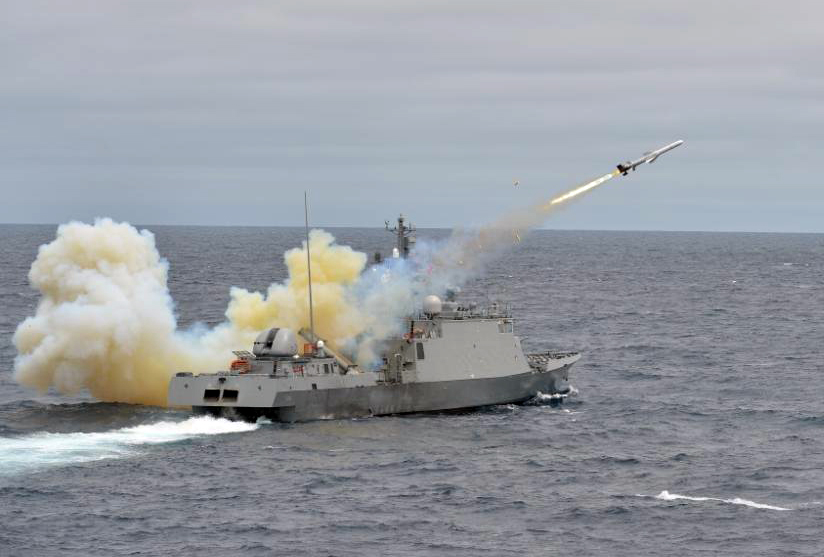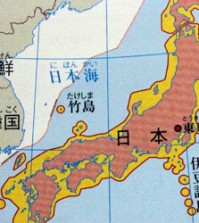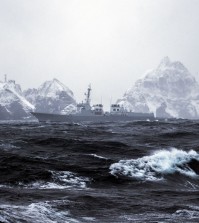- California Assembly OKs highest minimum wage in nation
- S. Korea unveils first graphic cigarette warnings
- US joins with South Korea, Japan in bid to deter North Korea
- LPGA golfer Chun In-gee finally back in action
- S. Korea won’t be top seed in final World Cup qualification round
- US men’s soccer misses 2nd straight Olympics
- US back on track in qualifying with 4-0 win over Guatemala
- High-intensity workout injuries spawn cottage industry
- CDC expands range of Zika mosquitoes into parts of Northeast
- Who knew? ‘The Walking Dead’ is helping families connect
Navy carrys out anti-sub, live-fire drill near Dokdo

ROKS Park Dong-jin, a patrol killer, guided-missile (PKG)-class ship, launches a ship-to-ship Haeseong missile during the Navy’s anti-submarine, live-fire drill near Dokdo on Friday. (Yonhap)
SEOUL (Yonhap) — The South Korean Navy carried out a firing exercise off the country’s east coast near its southeastern islets of Dokdo Friday to strengthen its capability against a possible invasion by North Korean submarines, officers here said.
Flatly rejecting Japan’s call a day earlier to cancel the drill, the Navy held the one-day exercise in the East Sea, some 50 kilometers away from the country’s eastern port of Jukbyeon, North Gyeongsang Province, as scheduled.
On Wednesday, Tokyo urged Seoul to cancel the exercise, claiming that the venue includes part of its territorial waters near Dokdo. It was the latest in a series of Tokyo’s renewed attempts to lay claims to South Korea’s rocky outcroppings.
Though the Navy has held the drill on a regular basis, it marks the first time that the military made it public. The last such a live-fire drill took place in 2012.
“The unusual move was due in part to the recent naval threat by North Korea. It is to show how resolute our military is against any attacks by North Korea,” a Navy officer said, requesting anonymity.
Earlier this week, North Korean leader Kim Jong-un visited its naval unit in the East Sea and guided a drill aboard its largest submarine, stressing the need to raise combat preparations and underwater operation capability.
Friday’s exercise that lasted for three hours from 9 a.m. was based upon a scenario where the South Korean Navy detects, chases and destroys a North Korean submarine that has invaded South Korean waters.
Mobilizing 19 naval ships, including a 3,200-ton KDX-I light destroyer ship, called Gwanggaeto the Great-class destroyer, two P-3CK anti-submarine surveillance aircraft and a Lynx antisubmarine helicopter, the Navy fired its homegrown torpedo named the Cheongsangeo, or Blue Shark; a ship-to-ship cruise missile named Haeseong, or Sea Star; and an air-to-ground missile named Harpoon into the sea, the Navy noted.
Adm. Hwang Ki-chul, the chief of the Naval Operations, who conducted the drill, ordered its officers to pursue, if provoked, the enemy’s submarines “to the end and bury them at sea,” according to the Navy.
Noting that the torpedo and cruise missile successfully hit the target, the Navy said it will further strengthen its readiness posture “with a firm resolution to turn the East Sea into a grave of the North’s submarines.”
Tokyo criticized the drill Friday, with its Chief Cabinet Secretary Yoshihide Suga calling the exercise “extremely regretful” at a press conference.
The South Korean Navy issued a no-sail notice for the waters about 20.1 kilometers south of Dokdo on Tuesday, and Japan was notified of the fact the following day, according to Seoul’s defense ministry.
“Conducting military drills for self-defense of the Republic of Korea is not a subject of any demand or interference. In accordance, the drill is under way as scheduled,” Seoul’s defense ministry vice spokesperson Wi Yong-seop told a regular briefing.
Japan has long laid claims to Dokdo in the country’s school textbooks, government reports and other ways, stoking enmity in South Korea against its former colonial ruler.
South Korea says such claims amount to Japan denying Korea’s independence from its 1910-45 colonial rule, as Seoul reclaimed sovereignty over all of its territory — including Dokdo and many other islands around the Korean Peninsula — upon its independence.
South Korea has been keeping a small police detachment on Dokdo since 1954.















